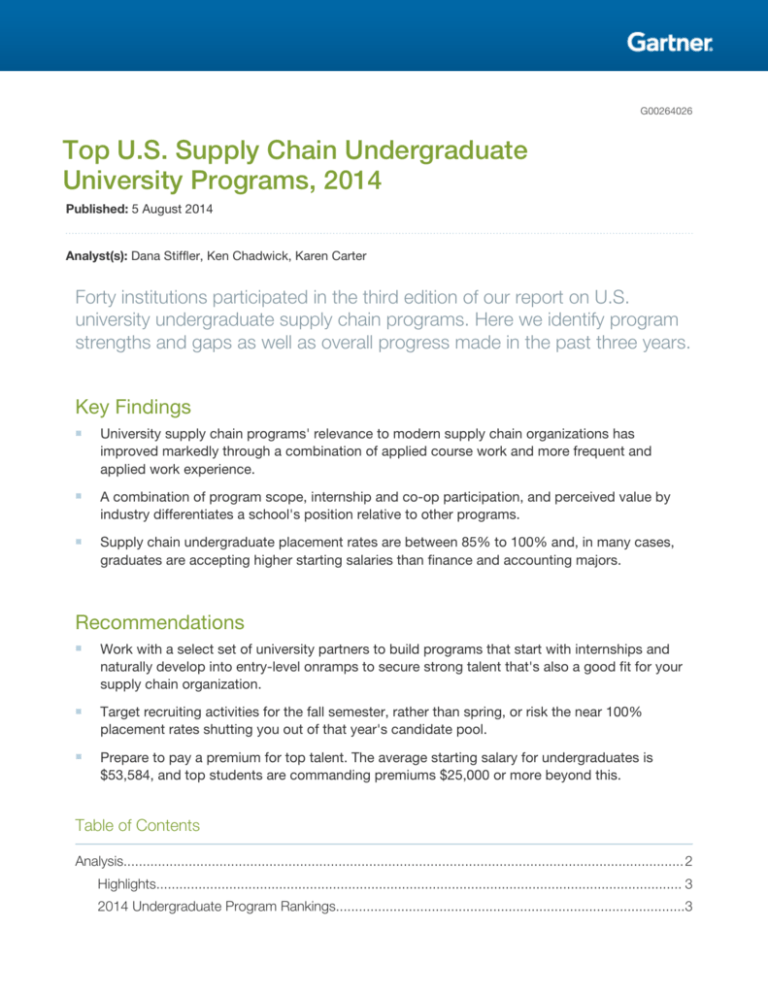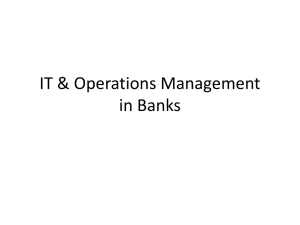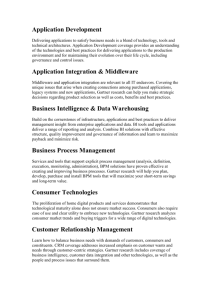
G00264026
Top U.S. Supply Chain Undergraduate
University Programs, 2014
Published: 5 August 2014
Analyst(s): Dana Stiffler, Ken Chadwick, Karen Carter
Forty institutions participated in the third edition of our report on U.S.
university undergraduate supply chain programs. Here we identify program
strengths and gaps as well as overall progress made in the past three years.
Key Findings
■
University supply chain programs' relevance to modern supply chain organizations has
improved markedly through a combination of applied course work and more frequent and
applied work experience.
■
A combination of program scope, internship and co-op participation, and perceived value by
industry differentiates a school's position relative to other programs.
■
Supply chain undergraduate placement rates are between 85% to 100% and, in many cases,
graduates are accepting higher starting salaries than finance and accounting majors.
Recommendations
■
Work with a select set of university partners to build programs that start with internships and
naturally develop into entry-level onramps to secure strong talent that's also a good fit for your
supply chain organization.
■
Target recruiting activities for the fall semester, rather than spring, or risk the near 100%
placement rates shutting you out of that year's candidate pool.
■
Prepare to pay a premium for top talent. The average starting salary for undergraduates is
$53,584, and top students are commanding premiums $25,000 or more beyond this.
Table of Contents
Analysis.................................................................................................................................................. 2
Highlights......................................................................................................................................... 3
2014 Undergraduate Program Rankings...........................................................................................3
The Research Methodology..............................................................................................................5
A Snapshot of Each Evaluation Criterion........................................................................................... 7
Program Scope.......................................................................................................................... 7
Industry Value.............................................................................................................................9
Program Size..............................................................................................................................9
Complete List of Participating Undergraduate Programs.............................................................9
Gartner Recommended Reading.......................................................................................................... 11
List of Tables
Table 1. 2014 Undergraduate Supply Chain Program Ranking............................................................... 4
List of Figures
Figure 1. Top Undergraduate Programs in Program Scope, Industry Value and Program Size................5
Figure 2. Three Evaluation Criteria for Undergraduate University Programs............................................. 6
Figure 3. Supply Chain Talent Attribute Model........................................................................................ 8
Analysis
Intended to support chief supply chain officers (CSCOs), heads of supply chain strategy and supply
chain HR partners in building a strong portfolio of university recruiting and internship partners,
Gartner's supply chain university research is back for its third iteration. U.S. undergraduate supply
chain programs have made impressive progress since we formally began this research in 2008,
efforts which have helped grow and improve the supply of supply chain talent. We see four
impressive areas of growth, three of which should be welcome news to industry:
■
The broadening of supply chain curricula to reflect the reality of today's supply chain
organizations.
■
The exposure of more students to internships and co-ops, and more applied project work —
often for sponsoring companies — in the classroom.
■
Dramatic increases in enrollment across the board, and new supply chain degree programs
being established.
The fourth area of growth, while perhaps not so welcome for the hiring companies, is great news for
supply chain professionals as a community: salaries are up roughly 10% over 2011. Top students
from top programs can command a 50% premium over the average and, in many programs, new
supply chain graduates handily outearn finance and accounting majors.
Page 2 of 12
Gartner, Inc. | G00264026
In the university community, competition between programs is intense, but friendly. With so much
growth in programs, and industry sponsors lining up to invest in universities' supply chain centers,
the sense is that supply chain has finally "arrived" as a profession.
Some details on the broad set of university participants and the undergraduate programs,
specifically:
■
Forty-four universities responded to Gartner's broad supply chain university program RFI.
■
Forty schools submitted information on undergraduate supply chain programs, 35 for graduate
programs.
■
Thirty-one programs are returning participants to the undergraduate project; nine are
newcomers. That is, they had existing supply chain programs, but have not previously
participated.
Highlights
■
Michigan State University and Pennsylvania State University have tied for the No. 1 position.
This is the first time there has been a tie for the No. 1 slot.
■
Newcomers to the list were Brigham Young University, the University of Houston, Northeastern
University, Miami University of Ohio and North Carolina State.
■
The most highly ranked new entrant in the undergraduate field was Brigham Young University
(No. 6).
■
The biggest upward movers in the ranking since our previous report were Tennessee (eight
places), Western Michigan (seven places), and South Carolina (six places) .
■
Many programs have made significant strides in program scope: although average program
scope is up only slightly, from 5.7 to 5.8 on a ten-point scale, the median score jumped from 6
to 7, the equivalent of adding 1.2 stations to each school's curriculum.
■
Thirty-one of 40 undergraduate programs offer formal training in supply chain applications and
tools; 29 teach supply chain analytics in some form, showing that programs have heard the
industry's demands for these skills loud and clear.
■
The average starting salary for undergraduates is $53,584. Top students are commanding
premiums $25,000 or more beyond this.
2014 Undergraduate Program Rankings
The top U.S. undergraduate supply chain programs balance broad curricula, real-world experience
and strong industry reputations to rise to the top. Penn State again claimed the No. 1 position, but
this time tied with another supply chain giant, Michigan State, for top honors. The biggest upstarts
this year were Western Michigan, Brigham Young University and the University of North Texas, all of
which shot into the top 10 (see Table 1), based on potent combinations of innovative curricula and
Gartner, Inc. | G00264026
Page 3 of 12
required internship participation. Schools that are fairly large and well-established, but have more
traditional, logistics-and-transportation-focused curricula, appear in the second half of the list.
Table 1. 2014 Undergraduate Supply Chain Program Ranking
1
Michigan State University
14
University of Houston
1
Penn State University
15
Northeastern University
3
University of Tennessee
16
Marquette University
4
University of Texas at Austin
17
The Ohio State University
5
Western Michigan University
18
Lehigh University
6
Brigham Young University
18
Syracuse University
6
University of North Texas
20
University of Oklahoma
8
Auburn University
21
Georgia Institute of Technology
9
Arizona State University
22
Miami University of Ohio
9
Rutgers University
22
Texas A&M University
11
University of Wisconsin
24
North Carolina State University
12
University of South Carolina
25
Rider University
13
Texas Christian University
25
University of Kansas
Source: Gartner (August 2014)
Data for this research is gathered through surveys and interviews of industry and academia. The
surveys are designed to identify industry sentiment and recruiting patterns, and to gather
information on university program composition, including numbers of students and professors, as
well as the scope of the curriculum. Three categories are evaluated, using the research
methodology detailed in Figure 2, to determine comparative position in the study. For a detailed
1
explanation, please see the Research Methodology section.
We explore program performance in greater detail in Figure 1. For program scope, where a diverse,
balanced program based on Gartner's Talent Attribute Model received the highest marks, the top
performer was Northern Texas University, followed closely by Arizona State, Kansas, Marquette,
Rutgers, Stanford and University of Texas.
Page 4 of 12
Gartner, Inc. | G00264026
Figure 1. Top Undergraduate Programs in Program Scope, Industry Value and Program Size
Program Scope Leaders
Industry Value Leaders
Program Size Leaders
Western Michigan University
Michigan State University
Michigan State University
Brigham Young University
Pennsylvania State University
Pennsylvania State University
Iowa State University
Georgia Institute of Technology
University of Houston
Rutgers University
The Ohio State University
Rutgers University
Auburn University
University of Wisconsin
University of Tennessee
Marquette University
Arizona State University
Arizona State University
Michigan State University
Northeastern University
The Ohio State University
Penn State University
University of South Carolina
Texas A&M University
University of Tennessee
Texas Christian University
University of Texas at Austin
University of Central Oklahoma
University of Houston
University of Kansas
University of North Texas
University of Oklahoma
Highest Score in Category
University of Tennessee
Second-Highest Score in Category
University of Texas at Austin
Third-Highest Score in Category
Source: Gartner (August 2014)
Michigan State, Penn State, Georgia Tech, Ohio State and the University of Wisconsin are all
closely grouped at the top of the industry value category. Penn State scores highest among all
universities for number of mentions by industry, which reflects its strong brand with the supply
chain community at large.
Programs that scored highest for internships were Auburn, BYU, North Carolina State,
Northeastern, North Texas, Rider University, Syracuse, University of Texas at Austin and Wisconsin,
all of which require internships or co-op participation.
The Research Methodology
Our methodology for this year's program assessments is similar to the methodology followed in the
2010-2011 research. We sent RFIs to our numerous contacts in U.S. supply chain programs. We
also followed up the RFIs with conversations with many of the schools, and conducted research on
university websites and course catalogs to ensure that the RFIs were complete and accurate.
Responses and clarifications were collected throughout the end of 2013.
Gartner, Inc. | G00264026
Page 5 of 12
The foundation for this ranking of supply chain programs was based on program-supplied RFI
information, but additional input into the "industry value" component of the ranking comes from
ongoing surveys of current supply chain and recruiting professionals. Supply chain leaders say that
the quality and effectiveness of the recruiting pool are improved when students have real-world
experience. Gartner, in turn, has responded by assessing each program's use of internships. This is
an indicator of a program's focus on providing relevant learning experiences for the real world and
the effectiveness of its industry partnerships (that is, the source of internships).
The evaluation criteria for the university programs appear in Figure 2. The final placement of
university programs in our relative comparison is based on a composite score of three categories:
program scope, industry value and program size.
The supply chain course score used for the "scope" ranking is based on the courses listed in RFI
responses and on the evaluation of course catalogs against the supply chain Talent Attribute Model.
A higher score indicates more complete coverage of the 12 supply chain stations.
Figure 2. Three Evaluation Criteria for Undergraduate University Programs
Undergraduate Program Scope
Criteria Weighting
Number of stations taught
40%
Undergraduate Industry Value
Recruit mentions
"Best" mentions
Undergraduate internships
40%
Average starting salary
Undergraduate Program Size
Number of full-time professors
Number of full-time students
20%
Source Key:
How well curriculum aligns to Gartner Talent Attribute Model
Industry respondents to Gartner CSCO and Research Circle Surveys
University respondents to Gartner RFI
Source: Gartner (August 2014)
Page 6 of 12
Gartner, Inc. | G00264026
A Snapshot of Each Evaluation Criterion
Program Scope
We framed the scope of a supply chain with an updated, slightly expanded version of the Gartner
Supply Chain Talent Attribute Model. We added two new stations, financial management and
demand-driven value networks (DDVNs). DDVN is a measure of focused cross-functional content in
a program. Examples encountered in our research include courses focused on "Life Cycle
Affordability" and "Supply Chain Performance Management." We collapsed two customer-facing
functions into one station: customer management/service supply chain, bringing the new number of
attributes to 12.
As we evaluated programs, we looked for curricula that aligned with the 12 stations of the model.
Our research since the late 2000s indicates that industry places a premium on supply chain recruits
that have a broad understanding of supply chain concepts and the cause-and-effect relationships
between the disciplines, what we call Supply Chain Orchestration (see "Drive Your Talent Strategy
Using Gartner's Supply Chain Talent Pillars").
We used an expanded Talent Attribute Model this year to assess completeness of university
curricula (see Figure 3). The model was initially created in 2008 and used in our first and second
university rankings (see "North American University Supply Chain Programs, Part 3: Ranking the
Top Programs" from 2011) (Note: This document has been archived; some of its content may not
reflect current conditions). We developed and tested it as a modern and comprehensive model,
incorporating the expanding breadth of capabilities that are found in a modern, high-performing
supply chain organization. The model is composed of 12 capabilities — one foundational, six
functional, four enabling and one cross-functional — based on our DDVN framework. We refer to
these 12 capabilities as "stations."
Gartner, Inc. | G00264026
Page 7 of 12
Figure 3. Supply Chain Talent Attribute Model
DDVN
Plan
New
Product Design
and Launch
DDVN
Source
Foundational
Business Skills
(e.g., Finance)
Cust. Mgmt./
Service
1
2
3
4
DDVN
Make
Deliver
DDVN
Foundational
Enabling
Functional
Cross-Functional
1. Finance
8. Strategy and
Change
Management
2. Plan
12. Demand-Driven
Value Network
9. Governance and
Project
Management
10. Performance
Management and
Analytics
11. Technology
Enablement
3. Source
4. Make
5. Deliver
6. Service/
Customer
Management
7. New Product
Design and
Launch
Source: Gartner (August 2014)
With the Talent Attribute Model as the capabilities framework for the ideal supply chain, we test
university curricula for the completeness of their offerings against the 12 stations. Effectively, we are
testing for curriculum alignment with the functional integration of a modern supply chain. It
continues to be relevant, as our latest surveys continue to show the expansion of the supply chain
organization (see "Survey Analysis: Chief Supply Chain Officers Conquer Organizational and
Capability Challenges to Grow") as well as a desire by industry for recruits who can grasp bigpicture, integrated supply chain concepts.
Page 8 of 12
Gartner, Inc. | G00264026
Industry Value
Once again this year, indicators of perceived industry value are the schools on which recruitment
efforts focus, the programs viewed as the "best" and the average starting salaries for program
graduates.
We also continue to include internships as a primary indicator of industry value. Our rationale is that
industry sets up internships in partnership with institutions where the overall program and its
students align well with a company's needs. Beyond that, we view programs that require internships
to be indicative of programs that are preparing students to solve real-world problems through realworld experience, which are two key and recurring gaps in our industry survey of university program
strengths. This year's assessment altered the methodology slightly to give credit on a sliding scale
to programs that put some students through internships; programs with higher percentages of
students going through internships get more points.
This combination of recruiting mentions, "best" mentions, average salary and internship exposure
makes up a composite view of perceived industry value.
Program Size
The number of supply chain students and professors in the program provides quantification of a
given university's ability to sustain a pipeline of supply chain recruits for industry. Even though the
need for quality and quantity of recruits for supply chain continues to be a theme as we talk to
industry clients, we continue to give program size a 20% weighting. We considered only full-time
professors engaged in classroom delivery of supply chain courses or research related to the supply
chain program.
Complete List of Participating Undergraduate Programs
Arizona State University
Auburn University
Boise State University
Brigham Young University
Colorado State University
East Carolina University
Georgia Institute of Technology
Howard University
Indiana University
Iowa State University
Gartner, Inc. | G00264026
Page 9 of 12
Lehigh University
Marquette University
Miami University of Ohio
Michigan State University
North Carolina State University
Northeastern University
Penn State University
Rider University
Rutgers University
Syracuse University
Texas A&M University
Texas Christian University
The Ohio State University
University of Central Oklahoma
University of Arkansas
University of Houston
University of Kansas
University of Maryland
University of Missouri - St. Louis
University of North Florida
University of North Texas
University of Oklahoma
University of San Diego
University of South Carolina
University of Tennessee
University of Texas at Austin
Page 10 of 12
Gartner, Inc. | G00264026
University of Texas at Dallas
University of Wisconsin
Washington University
Western Michigan University
Gartner Recommended Reading
Some documents may not be available as part of your current Gartner subscription.
"Drive Your Talent Strategy Using Gartner's Supply Chain Talent Pillars"
"Revise Supply Management Organizational Design and Talent Management to Meet Future Needs"
"Achieve Demand-Planning Functional Excellence by Establishing a Forward-Thinking Talent
Strategy"
"Survey Analysis: Chief Supply Chain Officers Conquer Organizational and Capability Challenges to
Grow"
Evidence
1
The fact base for this report was derived from primary research conducted by Gartner's
Quantitative Research Group as well as surveys conducted by the Gartner Supply Chain Research
team.
Gartner, Inc. | G00264026
Page 11 of 12
GARTNER HEADQUARTERS
Corporate Headquarters
56 Top Gallant Road
Stamford, CT 06902-7700
USA
+1 203 964 0096
Regional Headquarters
AUSTRALIA
BRAZIL
JAPAN
UNITED KINGDOM
For a complete list of worldwide locations,
visit http://www.gartner.com/technology/about.jsp
© 2014 Gartner, Inc. and/or its affiliates. All rights reserved. Gartner is a registered trademark of Gartner, Inc. or its affiliates. This
publication may not be reproduced or distributed in any form without Gartner’s prior written permission. If you are authorized to access
this publication, your use of it is subject to the Usage Guidelines for Gartner Services posted on gartner.com. The information contained
in this publication has been obtained from sources believed to be reliable. Gartner disclaims all warranties as to the accuracy,
completeness or adequacy of such information and shall have no liability for errors, omissions or inadequacies in such information. This
publication consists of the opinions of Gartner’s research organization and should not be construed as statements of fact. The opinions
expressed herein are subject to change without notice. Although Gartner research may include a discussion of related legal issues,
Gartner does not provide legal advice or services and its research should not be construed or used as such. Gartner is a public company,
and its shareholders may include firms and funds that have financial interests in entities covered in Gartner research. Gartner’s Board of
Directors may include senior managers of these firms or funds. Gartner research is produced independently by its research organization
without input or influence from these firms, funds or their managers. For further information on the independence and integrity of Gartner
research, see “Guiding Principles on Independence and Objectivity.”
Page 12 of 12
Gartner, Inc. | G00264026









